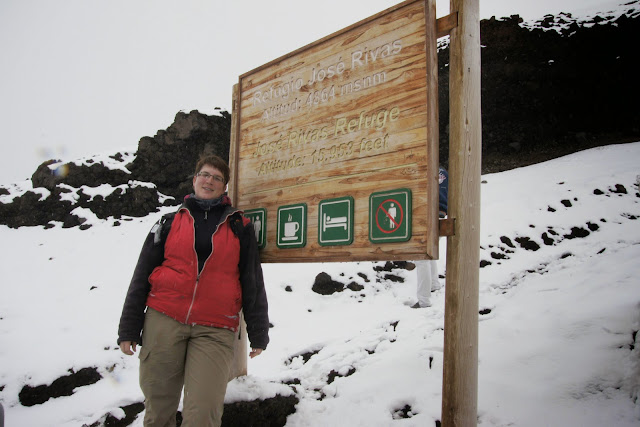After 2 nights on Isabella, I arrived back in Santa Cruz still quite early in the day. After getting sorted at my hotel, I started heading out to to explore the town, Puerto Ayora. It is a lot bigger compared to Isabella, but I had still seen the the main part quite quickly. (They do have a lot more souvenir shops though.)
I then started heading of to a beach about an hour walking distance away from town, Playa Bahía Tortuga. You couldn't get there by car (it also wasn't really crowded there), but it is a beautiful beach, with the possibility to see lots of iguanas, lizzards, crabs and birds. As I had another trip planned for the afternoon, I didn't go swimming here, but only walked along the beach, enjoying the view, and taking photos of the animals. After about an hour, I headed back into town.
In the afternoon I was going on a snorkling trip to a spot a bit further away from town on a boat. At first we landed at a small pier, to look at the animal in this area. Landing, however, was not that easy, as a group of sea lions had occupied the pier. Only after our captain had managed to convince them to leave were we able to actually get back on land. There we waked a bit through the bizarre landscape with cactusses and iguanas, before we went snorkeling in the bay with lots of colourful fish.
In the evening, the town became quite busy, with tourists, but also with locals going for dinner or a drink. The restaurants right in the first row were manynly visited by tourist. Two streets further back, however, (I had seen that there were some small food places during the day), the whole street had turned into a big restaurant. All the little food placed on the side had put their tables down in the street, offering freshly caught fish and especially lobster, (the amount of lobster there was quite impressive,) to be cooked on the many barbeques put up on the sides.
On the next day, I had planed a day trip to visit the uninhabited (by humans) island Seymour and go snorkeling. Seymour is a small island north of Baltra (the airport island), mainly inhabited by many birds, sea lions and iguanas. The boat therefore was leaving from the north of the island, where the ferry to the airport is as well. Also at this harbour, the boat couldn't come directly to the shore. Our boat had a small dinghy (or panga) boat (which was also needed for the landings on the trip), which braught us to the main boat.
The first stop was still on Santa Cruz, a beautiful beach, Playa Las Bachas. We had a so called wet landing, meaning the dinghy got as close to the beach as possible, so that we would get out with the feet still in the water. After looking around a bit at the areas of sea turtle nests (you couldn't really see much except sand), some of us went snorkeling in the bay. Along the lava rocks, hundreds of beautiful, colourful fish were swimming, from really tiny to quite big. Time flew by, suddenly an hour was gone, and part of the group (not all had actually gone in the water) were already back on board. Just as we snorkelers had finally come out of the water, our guide finally saw a turtle in the water (what we had hope for all the time while snorkeling). We the quickly got in the dinghy, and the guide took us out the the turtle, where we jumped back in the water to shortly see and swim with the turtle close up. Finally then, very happy, we returned back to the boat.
The second stop the was on the island Seymour. There we could actually have a dry landing, meaning the dinghy brought us to some rocks, from where we could climb further up to the island. We walked around the island for about 1.5 hours, watching all the different birds nesting, breeding, mating and feeding their young. We saw fregat birds, the male trying to impress the girls with their inflated red gular pouch. Or the babies (still huge birds) waiting for their parents to return with food. Also, several blue-footed boobies were nesting or trying to mate, looking really cute when they are showing off their blue feet. Of course we also saw sea lions relaxing in the sand or on the warm lava stones, or swimming along the coast, as well as iguanas, which always just seemed to enjoy the sun. After an evenful day, we returned back to Santa Cruz and Puerto Ayora in the late afternoon.
On my last day on Santa Cruz, I went on a tour into the highlands of the island, to see the giant (land) turtles. The turtles like completely free, and just pass though private farms on the way to search food. On these farms then the tourists can go to watch the turtles up closely. It is quite amazing to see how the move very slowly, especially with the size and weight of their shell.
Santa Cruz, like Isabella, has been formed by volcanos (although the volcanos on Santa Cruz are not active now). Still nowadays, labs tunnels can be found at several locations, where the lava on top already solidified, but the lava on the inside was still liquid and flowed out. After spending some times with the turtles, we went to visit one of these tunnels, and went through it (at one position crawled through it).
Afterwards we spent some addational time at another beach. Here the sand of the beach was interrupted at several location by lava fields, which gave it a quite unique appearance. As I was about to catch the next ferry, once more I didn't do swimming, but 'just' enjoyed the scenery.



